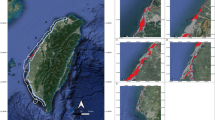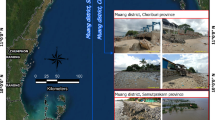Abstract
Most geologic and geomorphologic features emerged on a deltaic plain resulted from the interplay of marine, land and river, of which are some have the potential to be a geoheritage site, this is called a geomorphosite. Over time, human impact due to settlements on the geomorphosite, reshaped and transformed the site to geoarcheomorphosite. The Great Pelusium, or Tell El-Farama, which is located along the Tineh Plain at the NE extreme of the Nile Delta between the third and fifth c. AD, is classified as a geoarcheomorphosite. The location includes several geomorphosites, such as the accreted coastal ridges, which record Late Holocene sea level changes. It also includes traces of the flash flood on the Pelusiac branch during the eighth c. AD, with the fluvial flood plain, natural levee, and crevasse splays, on which the Great Pelusium, Tell El-Luli, Tell El-Fadah, and Tell El-Makhzan were constructed. Recently, the area subjected to a hub development project, which may represent anthropogenic hazards that threaten the Great Pelusium. This study aims to quantify the potential anthropogenic hazards. The change detection shows that in 1984 the area of the geoarcheomorphosites was 424.8 km2, representing approximately 67.1% of the Tineh Plain, in addition to the sand dune area of 75 km2, representing 11.8%. In 2018, the area saw agricultural activities, fish farms, and an urban expansion that covered approximately 244.2 km2, representing 38% of the Tineh Plain. The construction of a new hub in the Suez Canal corridor and the addition of a new community of one million people in an area of 164 km2, representing 30.3% of the plain, will add more pressure on the geodiversity. A conservation plan is recommended in the form of sustainable development to save an important area of geoheritage in Egypt and convert the area into a tourism destination.











Similar content being viewed by others
References
Abd El-Maksoud M (1984) Preliminary report on the excavation of tell el-Farama (Pelusium) first two seasons (1983/84 and 1984/5). ASAE 70:3–8
Abd El-Samie M (1992) Preliminary report on the excavations at tell el-Makhzan (Pelusium). CRIPEL 14:91–95
Almobaideen W, Allan M, Saadeh M (2016) Smart archaeological tourism: contention, convenience andaccessibility in the context of cloud-centric IoT. Mediterranean Archaeology and Archaeometry 16(1):227-236. https://doi.org/10.5281/zenodo.35535
Arnous MO, El-Rayes AE, Helmy AM (2017) Land-use/land-cover change: a key to understanding land degradation and relating environmental impacts in northwestern Sinai, Egypt. Environ Earth Sci 76:263–221. https://doi.org/10.1007/s12665-017-6571-3
Aquaotta F, Faccini F, Fratianni S, Paliaga G, Sacchini A (2018) Rainfall intensity in the Genoa Metropolitan Area (Northern Mediterranean): secular variations and consequences. Weather. https://doi.org/10.1002/wea.3208
Belen Castro M (2015) A historical review of the Egyptian calendars: the development of time measurement in ancient Egypt from Nabta playa to the Ptolemies. Sci Cult 1(3):15–27. https://doi.org/10.5281/zenodo.18446
Bonnet C, Abd El-Samie M (2004) Les églises de tell el-Makhzan. La campagne de fouille 2002, avec Une annexe de D. Dixneuf, « La céramique romaine tardive et byzantine de tell el-Makhzan. L’église méridionale et l’aire funéraire. Observations préliminaires, CRIPEL 24:5–45
Bonnet C, Abd El-Samie M, El-Tabai A (2004) L’église cruciforme tétraconque de Farama Sud à Péluse (Egypte). L’archéologue 73:31–33
Bonnet C, El-Tabai A, Carrez-Maratray JY, Abd El-Samie M (2010) Le temple romain, les bains et l’église tétraconque des faubourgs de Farama à Péluse (Nord Sinaï). Genava 58:142–163
Bouriant U (1900) Maqrizi: description Topographique et Historique de l’Egypte (part II) [translation of the 14th century Arabic work]. Mémoires Publiés par les Membres de la Mission Archéologique Française du Caire 17:371–748
Butler AJ (1996) The Arab conquest of Egypt and the last thirty years of Roman dominion (in Arabic). Madbouli Press, Cairo, Trans. M.F. Abu Hadid
Campbell JB (1987) Introduction to remote sensing. The Guilford Press
Chen H, Ye S, Zhang D, Zhang D, Areshkina L, Ablameyko S (2018) Change detection based on difference image and energy moments in remote sensing image monitoring. Pattern Recognit Image Anal 28:273–281
Coutellier V, Stanley DJ (1987) Late Quaternary stratigraphy and paleogeography of the eastern Nile Delta, Egypt. Mar Geol 77:257–275
Drury SA (2001) Image interpretation in geology. Nelson Thornes Blackwell Science, Cheltenham Malden 290
El-Asmar HM (1999) Late Holocene stratigraphy and lithofacies evolution of the Tineh plain northwestern corner of Sinai. Egypt Egypt J Geol 43(2):119–134
El-Asmar HM, Taha MMN, El-Kafrawy SB, El-Sorog AS (2015) Control of Late Holocene geo-processes on the sustainable development plans of the Tineh plain, NW Sinai coast, Egypt. J Coast Conserv 19:141–156. https://doi.org/10.1007/s11852-015-0377-9
El-Asmar H, Taha MMN, El-Sorogy AS (2016) Morphodynamic changes as an impact of human intervention at the Ras El-Bar-Damietta Harbor coast, NW Damietta promontory, Nile Delta, Egypt. J Afr Earth Sci 124:323–339
ENVI (2009) Atmospheric correction module: QUAC and FLAASH user’s guide.
EPM (2014) Master plan for Port Said East Port http://epmcon.com/ article/23883/Master-Plan-For-Port-Said-East-Port
ERDAS (2005) Field guide. Leica Geosystems Geospatial Imaging, LLC
Fernández JF, Alonso DA, González PA (2016) GIS and geoarchaeological analysis in superficial open-air sites: the case of Raña de Cañamero Neanderthal settlement (Guadiana Basin, Spain). Mediter Archaeol Archaeom 16(2):47–59
Foody G (2003) Remote sensing of tropical forest environments: towards the monitoring of environmental resources for sustainable development. Int J Remote Sens 24:4035–4046
Frihy OE, Lawrence D (2004) Evolution of the modern Nile Delta promontories: development of accretional features during shoreline retreat. J Environ Geol 46:914–931
Frihy OE, Lotfy MF (1997) Shoreline changes and beach-sand sorting along the northern Sinai coast of Egypt. Geo-Mar Lett 17:140–146
Gaber A, Geriesh MH, Shaheen S, El-Fattah MA (2016) Mapping the surface changes in the area of east port-said, Egypt using multi-temporal and multi-sensors remote sensing data. IOSR J App Geol Geophy (IOSR-JAGG) 4(5):19–29
GAFI (2014) MEGA projects integrate development at the center of the of the Suez Canal. http://www.mfa.gov.eg/MFANews/NewsArabic/Documents/Mega%20Projects%2023-1-2013.pdf
Gamba P, Dell’acqua F, Houshmand B (2003) Comparison and fusion of LiDAR and InSAR digital elevation models over urban areas. Int J Remote Sens 24(22):4289–4300. https://doi.org/10.1080/0143116031000096005
Goodfriend GA, Stanley DJ (1999) Rapid strand-plain accretion in the northeastern Nile Delta in the 9th century AD and the demise of the port of Pelusium. Geology 27:147–150
Hadeel A, Jabbar M, Chen X (2011) Remote sensing and GIS application in the detection of environmental degradation indicators. Geo-spat Inf Sci 14(1):39–47
Herold M, Scepan J, Clarke KC (2002) The use of remote sensing and landscape metrics to describe structures and changes in urban land uses. Environ Plan 34:1443–1458
Hussain M, Chen D, Cheng A, Wei H (2013) Change detection from remotely sensed images: from pixel-based to object-based approaches. ISPRS J Photo Remote Sens 80:91–106
Ibrahim EH, Sherief MR, Al-Metwally AA (1998) Shallow geophysical investigations on tell el Farama, Northwest Sinai. Egypt Archaeol Prospect 5:91–100
Kaimaris D (2018) Ancient theaters in Greece and the contribution of geoinformatics to their macroscopic constructional features. Sci Cult 4(3):9–25. https://doi.org/10.5281/zenodo.1409800
Kaiser M (2009) Environmental changes, remote sensing, and infra structure development: the case of Egypt’s East Port Said harbour. Appl Geogr 29:280–288
Lillesand TM, Kiefer RW, Chipman JW (2004) Remote sensing and image interpretation. John Wiley & Sons 763
Lu D, Mausel P, Brondizio E, Moran E (2004) Change detection techniques. Int J Remote Sens 25:2365–2404
Manley B (1996) Historical atlas of ancient Egypt. Penguin Books, London, p 144
Mather PM (1999) Computer processing of remotely-sensing images, an introduction (2nd ed.). Chichester: John Wiley and Sons, pp. 1–75.
Memarsadeghi N, Netanyahu NS, LeMoigne J (2007) A fast implementation of the ISODATA clustering algorithm Int J Comp Geom App
Mishra K, Prasad P (2015) Automatic extraction of waterbodies from Landsat imagery using perceptron model. J Comp Env Sci:1–8
Monterroso-Checa A (2017) Remote sensing and archaeology from Spanish Lidar-PNOA: identifying the amphitheater of the Roman city of Torreparedones (Córdoba-Andalucía-Spain). Mediter Archaeol Archaeom 17(1):15–22. https://doi.org/10.5281/zenodo.258079
Mousa AB (2019) Monitoring building materials exposed to marine environment: examples from Farasan Islands. Saudi Arabia Sci Cult 5(2):7–20
Neev D, (1977) The Pelusium line—a major trans-continental shear. Tectonophysics 38(3–4), T1–T8
Neev D, Greenfield L, Hall JK (1985) Slice tectonics in the Eastern Mediterranean Basin. In: D.J. Stanley and F.C. Wezel (Editors), Geological Evolution of the Mediterranean Basin. Springer, New York N.Y., pp.249–269
Parcak SH (2003) Archaeological evidence for abrupt climate change: results from\ satellite imagery analysis and subsequent ground truthing in the El-Manzalah region, Northeast Egyptian Delta. http://adsabs.harvard.edu/abs/2003AGUFMPP22C..03P
Pennington BT, Bunbury JM, Hovius N (2016) Emergence of civilisation, changes in fluvio-deltaic styles and nutrient redistribution forced by Holocene Sea-level rise. Geoarchaeology 31(3):194–210
Pennington BT, Sturt F, Wilson P, Rowland J, Brown AG (2017) The fluvial evolution of the Holocene Nile Delta. Quaternary Sci Rev 170: 212:–231
Quintanar J, Khan S, Fathy MS, Zalat AAM (2013) Remote sensing, planform, and facies analysis of the plain of Tineh, Egypt for the remains of the defunct Pelusiac River. Sediment Geol 297:16–30
Rashad HM, Abdel-Azeem AM (2010) Lake Manzala, Egypt: a bibliography. Assiut Univ J Botany 39(1):253–289
Sabins FF (1997) Remote sensing principles and interpretation. H. Freeman Company, New York, pp 366–371
Salem BB, El-Cibahy A, El-Raey M (1995) Detection of land cover classes in agro ecosystems of northern Egypt by remote sensing. Int J Remote Sens 16(14):2518–2594
Sestini G (1989) Nile delta: a review of depositional environments and geological history. In: Whateley MKG, Pikering KT (eds) Deltas: sites and traps for fossil fuels, 41. Geological Society Special Publication, Blackwell Scientific Publications, pp 99–127
Shalaby A, Tateishi R (2007) Remote sensing and GIS for mapping and monitoring land cover and land-use changes in the northwestern coastal zone of Egypt. Appl Geogr 27:28–41
Sneh A, Weissbrod T (1973) Nile delta: the defunct Pelusiac branch. Science 180:59–61
Sneh A, Weissbrod T, Perath I (1975) Evidence for ancient Egyptian frontier canal. Am Sci 63:543–548
Srivastava PK, Han D, Rico-Ramirez MA, Bray M, Islam T (2012) Selection of classification techniques for land use/land cover change investigation. Adv Space Res 50(9:1250–1265
Stanley DJ (2005) Submergence and burial of ancient coastal sites on the subsiding Nile delta margin, Egypt. Méditerranée 1(2):65–73
Stanley DJ, Toscano M (2009) Ancient archaeological sites buried and submerged along Egypt’s Nile Delta coast: gauges of Holocene Delta margin subsidence. J Coast Res 25(1):158–170
Stanley DJ, Warne AG (1993) Nile delta, recent geological evolution and human impact. Science 260:628–634. https://doi.org/10.1126/science.260.5108.628
Stanley DJ, Warne AG (1998) Nile delta in its destruction phase. J Coast Res 14:794–825
Stanley DJ, Bernasconi MP, Jorstadt TF (2008) Pelusium, an ancient port fortress on Egypt’s Nile Delta coast: its evolving environmental setting from foundation to demise. J Coast Res 24(2):451–462
Taha MMN, El-Asmar HM (2019) Geo-archeoheritage sites are at risk, the Manzala lagoon, NE Nile Delta coast, Egypt. Geoheritage 11:441–457. https://doi.org/10.1007/s12371-018-0297-9
Thomas IL, Benning VM, Ching NP (1987) Classification of remotely sensed images. Adam Hilger, Bristol
Yuan J, Niu Z (2008) Evaluation of atmospheric correction using FLAASH. In IEEE international workshop on earth observation and remote sensing applications. EORSA: 1–6. Beijing. https://doi.org/10.1109/eorsa.2008.4620341
Yuan F, Sawaya KE, Loeffelholz BC, Bauer ME (2005) Land cover\ classification and change analysis of the twin cities (Minnesota) metropolitan area by multitemporal Landsat remote sensing. Remote Sens Environ 98:317–328
Zaafarany N, Alsahar S (2014) The prospects of developing Suez Canal region- a futuristic vision. Vienna 10th International Academic Conference.
Acknowledgments
The authors thank the Deanship of Scientific Research and the Researchers Support and Services Unit at King Saud University for their technical support.
Funding
This study was financially supported by the Deanship of Scientific Research at King Saud University through Research Group No. RG-1439-061.
Author information
Authors and Affiliations
Corresponding author
Rights and permissions
About this article
Cite this article
Taha, M.M.N., Al-Hashim, M.H. & El-Asmar, H.M. Geoarcheomorphosites under Strong Urbanization Pressure at the Tineh Plain, NE of the Nile Delta, Egypt. Geoheritage 12, 24 (2020). https://doi.org/10.1007/s12371-020-00444-9
Received:
Accepted:
Published:
DOI: https://doi.org/10.1007/s12371-020-00444-9




